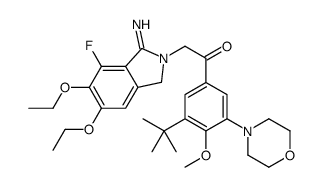| Description |
Atopaxar (E5555) is a potent, orally active, selective and reversible thrombin receptor protease-activated receptor-1 (PAR-1) antagonist. Atopaxar interferes with platelet signaling. Atopaxar can be used for the research of atherothrombotic disease[1][2].
|
| Related Catalog |
|
| Target |
PAR-1[1]
|
| In Vitro |
Atopaxar inhibits haTRAP (high-affinity thrombin receptor activating peptide) binding to PAR-1 on human platelet membranes in a concentration-dependent manner with an IC50 of 0.019 μM[2]. Atopaxar inhibits human platelet aggregation induced by thrombin or TRAP in a concentration-dependent manner[2]. Atopaxar does not inhibit PRP (platelet-rich plasma) aggregation induced by ADP, U46619, collagen, and PAR-4ap, up to a concentration of 20 μM[2].
|
| In Vivo |
Atopaxar (30-100 mg/kg; p.o.) prolongs the time to occlusion by 1.8-fold and 2.4-fold, respectively, compared with controls[2]. Atopaxar does not prolong bleeding time in guinea pigs at the highest tested dosage of 1000 mg/kg[2]. Animal Model: Guinea pigs, photo-chemically-induced thrombosis (PIT) model[2] Dosage: Oral administration Administration: 10 mg/kg, 30 mg/kg, 100 mg/kg Result: At 30 and 100 mg/kg prolonged the time to occlusion by 1.8-fold and 2.4-fold, respectively, compared with controls.
|
| References |
[1]. Chris Dockendorff, et al. Discovery of 1,3-Diaminobenzenes as Selective Inhibitors of Platelet Activation at the PAR1 Receptor. ACS Med Chem Lett. 2012 Mar 8; 3(3): 232–237. [2]. Motoji Kogushi, et al. The novel and orally active thrombin receptor antagonist E5555 (Atopaxar) inhibits arterial thrombosis without affecting bleeding time in guinea pigs. Eur J Pharmacol. 2011 Apr 25;657(1-3):131-7.
|
